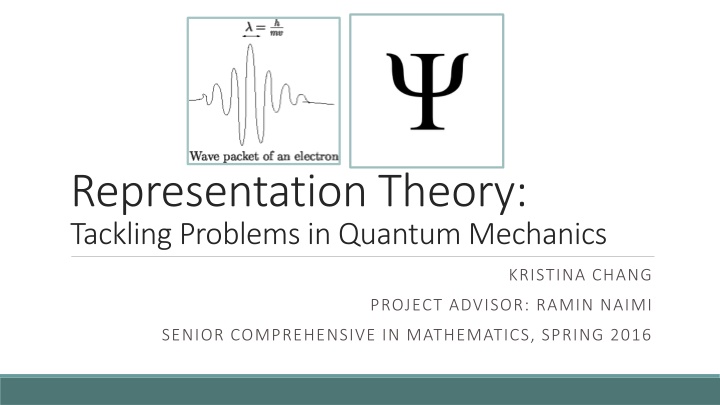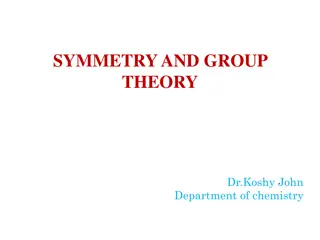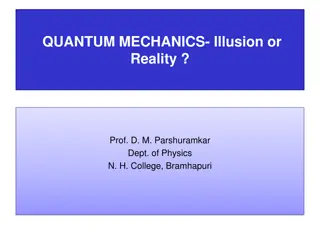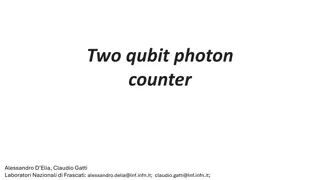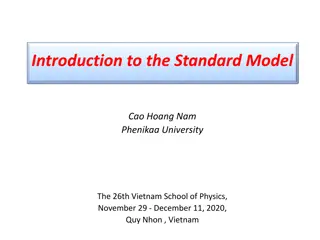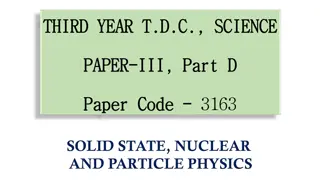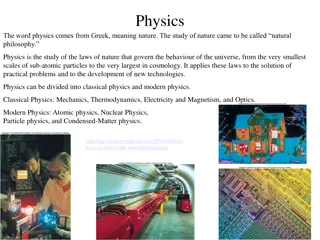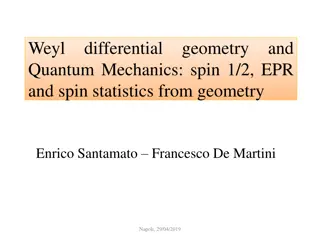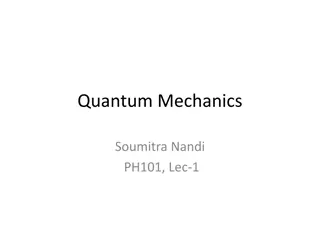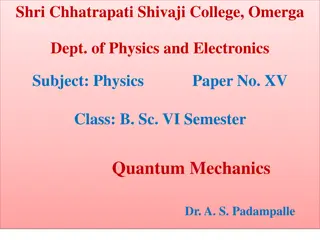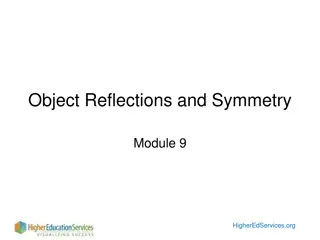Representation Theory in Quantum Mechanics: Tackling Problems with Symmetry
Dive into the world of quantum mechanics through the lens of representation theory, exploring solutions to Schrödinger equations, stationary states, and intrinsic symmetry. Discover how to translate quantum problems involving symmetry groups using linear algebra and group homomorphisms.
Download Presentation

Please find below an Image/Link to download the presentation.
The content on the website is provided AS IS for your information and personal use only. It may not be sold, licensed, or shared on other websites without obtaining consent from the author.If you encounter any issues during the download, it is possible that the publisher has removed the file from their server.
You are allowed to download the files provided on this website for personal or commercial use, subject to the condition that they are used lawfully. All files are the property of their respective owners.
The content on the website is provided AS IS for your information and personal use only. It may not be sold, licensed, or shared on other websites without obtaining consent from the author.
E N D
Presentation Transcript
Representation Theory: Tackling Problems in Quantum Mechanics KRISTINA CHANG PROJECT ADVISOR: RAMIN NAIMI SENIOR COMPREHENSIVE IN MATHEMATICS, SPRING 2016
Meet the wavefunction wavefunction ? ?,? 1) Wavefunctions are solutions to ? ??? ?,t t-dependent Schrodinger Eq: ? ?(r r,t)=? where ? is the Hamiltonian Operator: H = T + V 2) Stationary states (special ? s) are solutions to t-independent Schrodinger Eq: ? ? ? = ?? ? Symmetry? where E is a constant GOAL: Solve for ? in cases were H has intrinsic symmetry using Representation Theory. 2 KRISTINA CHANG REPRESENTATION THEORY IN QUANTUM MECHANICS SPRING 2016
Roadmap Roadmap 3 KRISTINA CHANG REPRESENTATION THEORY IN QUANTUM MECHANICS SPRING 2016
Representing a mathematical entity A with a mathematical entity B. What is a representation? Group (H) Matrices B A Why is this useful? Translate problems in QM involving H (symmetry- group) into a linear algebra 4
What is a representation? Def. A representation of a group G is a group homomorphism : G GL(n,C). Group homomorphism: (g1 g2) = (g1) (g2) g1 ? ? ? ? ? ? ? ? ? ? ? ? g3 g2 G GL(2,C) 5 KRISTINA CHANG REPRESENTATION THEORY IN QUANTUM MECHANICS SPRING 2016
What groups can we represent? Symmetry group: The symmetry of an object can be classified by a set of actions symmetry operations which preserve its position, shape, and orientation. y Composition of rotations forms a closed group. 2 C4C4 C4 C4 1 2 Notation: ?? ( Cn )m = ?? rotate by?/n ? rotate by (?/n), m times x 4 3 6 KRISTINA CHANG REPRESENTATION THEORY IN QUANTUM MECHANICS SPRING 2016
What groups can we represent? Pure Rotation Groups Cyclic!!! 0, Cn 1, ,Cn n 1} Consider < Cn > = {Cn y 1 2 How can we represent < Cn > with matrices? x Rotations are linear transformations! 4 3 R ???? ???? ???? ???? Intuitive representation: Let : <C4> GL(2,C) be given by ? ????? ????? ????? ????? where ?? = m?/4 ?4 7 KRISTINA CHANG REPRESENTATION THEORY IN QUANTUM MECHANICS SPRING 2016
At this point, we have 1) seen a formal definition of a representation 2) explored one intuitive way to constructa representation Irreducible representations We will soon introduce reducibility (a property of a representation). But first we ll need a few important concepts: New notation Ways to generate new rep s from old ones 8
Sizes and Sums A note about notation: Suppose G = { g1, g2, g3, , gn },and let be a representation of G. We will often refer to by the image set of : { | =1, 2, , n =1, 2, , n } where i = (gi)for all i. For convenience, we will abbreviate { } Remember: { } = ? ? ? ?, ? ? ? ? ? ? ?, , ? 9 KRISTINA CHANG REPRESENTATION THEORY IN QUANTUM MECHANICS SPRING 2016
Let a representation of G be given by : G GL(n,C). Sizes and Sums Def 1. The dimensionalityof the representation is n. Suppose : G GL(n,C) and : G GL(m,C) are representations of G. Def. {[ (?1)], [ (?2)], , [ (??)] } {[ (?1)], [ (?2)], , [ (??)] } The direct sum of and is the homomorphism : G GL(n+m,C) given by ( )(g) = ( )(g) =[ (?)] 0 ?? 0 [ (?1)] 0 0 [ ?2] 0 0 0 [ (?)] for all g G [ (?1)], [ (?2)], , 0 ?? 10 KRISTINA CHANG REPRESENTATION THEORY IN QUANTUM MECHANICS SPRING 2016
Reducibility Th. Suppose : G GL(n,C) is a representation of G. If = , for some functions and , then and are themselves representations of G. Leads us to idea of reducibility: Def. If there is some matrix P such that for all g in G, Rep can be decomposed into a direct sum of lower-dimensional rep s and (g) = P-1 (g) (g) P for some nontrivial functions and , then is a reducible representation of G. Else, is an irreducible representation of G. 11 KRISTINA CHANG REPRESENTATION THEORY IN QUANTUM MECHANICS SPRING 2016
Practice using def. of irreducibility: Reducibility Th. All 1-dimensional representations of a group are irreducible. Proof. There are no representations with a dimension less than 1. 1-dimensional representation can never be decomposed as a direct sum 12 KRISTINA CHANG REPRESENTATION THEORY IN QUANTUM MECHANICS SPRING 2016
Consequences of Irreducibility Groups have a complete set of irreducible representations. (basis for reducible representations) Linear algebra applied to the def. of irreducibility Great Orthogonality Theorem - stringent criteria on irreducible rep s Allows us to derive a complete set of all irreducible representations for most common symmetry groups 13 KRISTINA CHANG REPRESENTATION THEORY IN QUANTUM MECHANICS SPRING 2016
Irreducible representations for < ??> Complete Table of Irreducible Rep s where ? = ?2??/? 2 ? 1 Elements of group ? ?? 1 ? ?? ?? 1 2 ? 1 1 1 1 Matrices in the image set of the irr. rep. ?2 ?? 1 ?? 1 ?? 2 ?(? 1)2 1 14 KRISTINA CHANG REPRESENTATION THEORY IN QUANTUM MECHANICS SPRING 2016
So far We showed how a symmetry group can be represented using matrices Presented a complete set of irreducible representations for cyclic groups Quantum Mechanics What s this got to do with Quantum Mechanics? Recall: We want to utilize symmetries in H to make solving for ? ? easier. (Hint: H belongs to a symmetry group!) 15
Group of the Hamiltonian The Symmetry of the Hamiltonian Suppose R is an operation under which H is invariant: R-1 H R = H Eq. 6.2 If R satisfies Eq. 6.2, we say that R is a symmetry operation of the Hamiltonian H. The Group of the Hamiltonian The set of all symmetry operations {??}of a Hamiltonian forms a group. Th. This means we can represent {??}! 16 KRISTINA CHANG REPRESENTATION THEORY IN QUANTUM MECHANICS SPRING 2016
Time-independent SE: H ? = E ? The Schr dinger Equations Eigenvalue equation! eigenvalue E, eigenfunction ? ? Properties: (parallels to Linear Algebra!) 1) DistinctE s have orthogonal ? s 2) E may have multiple orthogonal ? s. If E does not have multiple orthogonal ? s, then E is non-degenerate. If E has exactly n distinct eigenfunctions, E is n-degenerate. 17 KRISTINA CHANG REPRESENTATION THEORY IN QUANTUM MECHANICS SPRING 2016
We are now almost ready to prove The Bridging Theorem: The Bridging Theorem Quantum Mechanics Representation Theory But first, we need a few lemmas 18
Lemmas Lemma 1. Symmetry operations generate eigenfunctions. Suppose H ? = E?. If ??is a symmetry operation of H, then H (???) = E (???) Lemma 2. Symmetry operations phase shift ? for non-degenerate E. Suppose E is non-degenerate, then ??? = ????? for some complex number ????. 19 KRISTINA CHANG REPRESENTATION THEORY IN QUANTUM MECHANICS SPRING 2016
The Bridging Theorem: non-degenerate case Hamiltonian eigenfunctions form a basis for irreducible representations. Suppose {??}is the group of the Hamiltonian H. Suppose H?= E?, where E is non-degenerate. (We will consider the degenerate case separately) Consider the set of complex numbers { ???? } { ????| ??? = ????? where ?? is a symmetry op.} Th 6.3a. { ???? } is an irreducible representation of ??. 20 KRISTINA CHANG REPRESENTATION THEORY IN QUANTUM MECHANICS SPRING 2016
Hamiltonian eigenfunctions form a basis for irreducible representations. The Bridging Theorem Th 6.3a. { ???? } is an irreducible representation of ??. Proof. ?:{??} GL(1,C), ? ?? = ???? where ??? = ?????. Show ? is a homomorphism. By def ?(????) ? = ?????? = ????? = ??????? = ????????? = ?(??)?(??)? Since, ?(????) = ?(??)?(??), the image set { ????}is a representation. Since it is 1-dimensional, it is irreducible. 21 KRISTINA CHANG REPRESENTATION THEORY IN QUANTUM MECHANICS SPRING 2016
The Bridging Theorem: degenerate case Suppose H? = E?, and that E is n-degenerate. Let {R } be the group of the Hamiltonian H. Consider the set of eigenfunctions { Ra ? | Ra {R } } of E. Def. If { Ra? | Ra {R } } contains all n distinct eigenfunctions of E, then its eigenfunctions are said to be normal degenerate. Repeated application of Ra on ? complete set of normal degenerate ? s 22 KRISTINA CHANG REPRESENTATION THEORY IN QUANTUM MECHANICS SPRING 2016
The Bridging Theorem: degenerate case Suppose {??}is the group of the Hamiltonian H. Suppose E is an eigenvalue of H with n normal degenerate eigenfunctions ?= ( 1, 2, , ?). For a given symmetry operation ?? Let ?? be the nxn matrix which satisfies ??? = ? ?? Th 6.3b. The set of nxn matrices { ? ?? } is an n-dimensional irreducible representation of {??}. 23 KRISTINA CHANG REPRESENTATION THEORY IN QUANTUM MECHANICS SPRING 2016
The Bridging Theorem Th 6.3b. The set of nxn matrices { ? ?? } is an n-dimensional irreducible representation of {??}. Proof. (i) Show that { ? ?? } is a representation. Recall def. of Recall def. of ?: : ??? = ? ? ?? Show R?R? = R? R?. ? R?R? = R?R?? = R? ? R? = ? R? R?. Since the matrices in { R? } are all nxn, { R? } is an n-dimensional representation. (ii) Show that { ? ?? } is irreducible. (given) 24 KRISTINA CHANG REPRESENTATION THEORY IN QUANTUM MECHANICS SPRING 2016
In Summary Normal degenerate families of eigenfunctions ? Application of Representation Theory interact with the group of the Hamiltonian {??} to generate irreducible rep s { ? ?? } . We will use this result to derive Bloch s Th: form of eigenfunctions for electrons in a crystal 1. find group of the Hamiltonian {??} 2. already know irreducible rep s { ? ?? } 3. decide what eigenfunctions ?must look like 25
1-D crystal 1-D lattice of positive ions V(x) + + + + a x N ions in the unit cell spaced a distance a apart Build crystal by applying periodic boundary condition N discrete symmetries Now, H is symmetric under any operator ?? such that ??? ? = ? ? + ? , and (??)?= ?0= ? < ??> = group of the Hamiltonian 26 KRISTINA CHANG REPRESENTATION THEORY IN QUANTUM MECHANICS SPRING 2016
Blochs Theorem: 1-D What are the irreducible representations of < ??> ? Recall: For a cyclic group < ??>of order N where ? = ?2??/? Table of Irreducible rep s of < ??> ??2 1 ?2 ??? 1 1 ?? 1 ? ?? 1 ? 1 2 ? 1 1 ?? 1 ?? 2 ?(? 1)2 1 27 KRISTINA CHANG REPRESENTATION THEORY IN QUANTUM MECHANICS SPRING 2016
Recall: (??)?? ? = ? ? + ?? Bloch s Theorem: 1-D What does ??? look like? Suppose ?? is the eigenfunction which generates { ? }. Then ?? ??? = ??? ??? = ??? ?? 1. We know ?? ??? = ??? + ? , ??? ?? 1= ??? + ? . |??? + ? |2= |??? ?? 1|2= |??? |2 So, Then, Eq. 6.5 General solution to Eq. 6.5: ??? = ????(?) ??? ????(?) Phase function Periodic function ??? = ??? + ? 28 KRISTINA CHANG REPRESENTATION THEORY IN QUANTUM MECHANICS SPRING 2016
Blochs Theorem: 1-D ??? = ????(?) ??? General solution: Now apply boundary conditions to ??? ?????? = ??? + ??= ??? ??(? 1), ????(?+??) ??? + ?? =????(?) ??? ??(? 1) ????(?+??) ??? =????(?) ??? ??(? 1) ????(?+??)= ????(?) ??(? 1) 2?? ? ?(? 1) ????(?+??)= ????(?) ? ?? ? ??? + ?? = ??? + ?(? ?) condition on ??(?) 29 KRISTINA CHANG REPRESENTATION THEORY IN QUANTUM MECHANICS SPRING 2016
Blochs Theorem: 1-D 2? ?? Given: ??? = ? + ???, ??= ? 1 , some constant B Substitute ??? into general solution for ??? : ??? = ????(?) ??? = ??(?+???) ??? = ????? ??? Bloch functions ??? = ????? ??? The eigenstates of a 1-D crystal lattice (periodic function modulated by a plane wave) 30 KRISTINA CHANG REPRESENTATION THEORY IN QUANTUM MECHANICS SPRING 2016
Representation Theory: We showed that symmetry groups can be represented by matrices. Cyclic groups have special sets of irreducible representations. Summary Quantum Mechanics: Hamiltonian belong to symmetry groups. We can map eigenfunctions (wavefunctions) to irreducible representations in the Hamiltonian. This helps us to solve for eigenfunctions (wavefunctions) of a 1-D crystal with only a knowledge of Hamiltonian symmetry. 31
Acknowledgements Friends Professor Naimi Faculty Professor Buckmire All of you!
References [1] Vedensky, Dimitri. Group Theory: Course Notes (2001). http://www.cmth.ph.ic.ac.uk/people/d.vvedensky/courses.html [2] Cotton, Albert. Chemical Applications of Group Theory (2003). John Wiley and Sons, Inc. [3] Saracino, Dan. Abstract Algebra: A First Introduction (2008). Waveland Pr, Inc. 33 KRISTINA CHANG REPRESENTATION THEORY IN QUANTUM MECHANICS SPRING 2016
Blochs Theorem: 1-D What does ??(?) look like? We know ?? ? ??? + ?? = ??? + ? ? ? Eq. 6.10 If we hold x and n constant,?? looks like a linear function of m. Cute trick: So ?? is a linear function of am + ?. ??? = ? am + ? + ? So we can write ??? = ? + ?? Substitute into Eq. 6.10: 2? ? ? + ? ? + ?? = ? + ?? + ? ? 1 2? ?? ? = ? 1 = ?? Solve for A: 34 KRISTINA CHANG REPRESENTATION THEORY IN QUANTUM MECHANICS SPRING 2016
